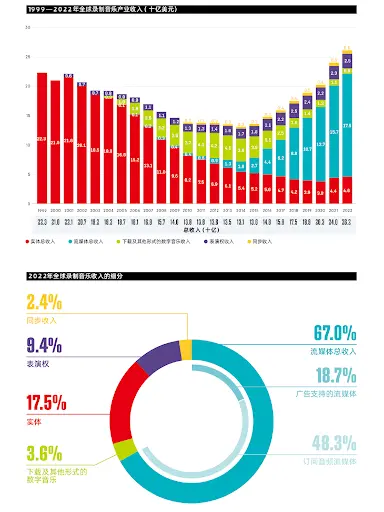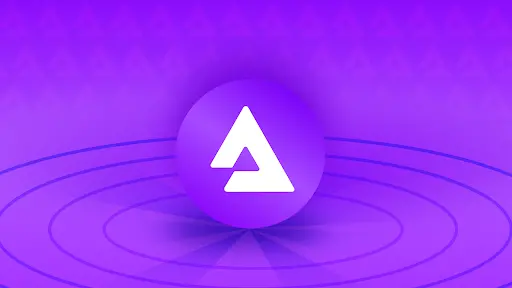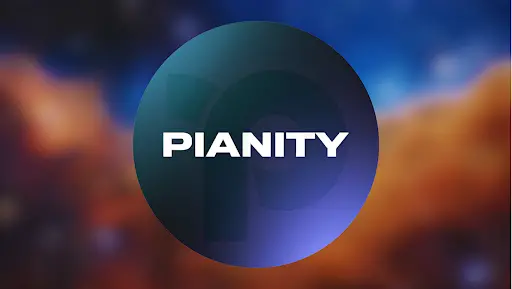Author: Gala music
I. Overview of the Music Market
1.1 Traditional Music Market Situation
The growth of the global music market has shown strong momentum over the past decade, especially with the rise of digital music and streaming services bringing disruptive changes. According to the 2023 Global Music Report released by the International Federation of the Phonographic Industry (IFPI), driven by the growth of paid subscription streaming, the global recorded music market grew by 9.0% in 2022, with total annual revenue reaching $26.2 billion. By the end of 2022, the global paid subscription user base reached 589 million, with subscription audio streaming revenue growing by 10.3% to $12.7 billion; total streaming revenue (including paid subscriptions and ad-supported) grew by 11.5% to reach $17.5 billion, accounting for 67.0% of global recorded music revenue. In addition to streaming revenue, other areas also saw growth, with physical revenue increasing by 4.0%, performance rights revenue growing by 8.6%, returning to pre-pandemic levels, and synchronization revenue increasing by 22.3%.

These data show that even in the face of global economic challenges, the music industry continues to maintain strong growth. In particular, streaming services such as Spotify and Apple Music are now the primary way of music consumption. According to Statista's 2023 data, by the end of 2022, the total number of global music streaming subscribers had reached 590 million, with Spotify having 188 million subscribers, accounting for 31.8% of the total global subscribers. Following closely are Apple Music and YouTube Music, with 88 million and 80 million subscribers, respectively.
1.2 Key Market Participants
In the traditional music market, various participants play different roles, collectively forming the ecosystem of the music industry.
(1)Artists
Artists are at the core of the music industry, creating music and sharing it with audiences through various channels. In the traditional model, most artists need to sign with record companies to gain wider market exposure and commercial success. However, digitalization and the internet have provided independent artists with more self-promotion and direct profit avenues.
(2)Consumers
Consumer music consumption behavior has evolved with technological advancements. From purchasing physical media (such as records and CDs) to downloading music files, and now to subscribing to streaming services to listen to music, consumption patterns are rapidly changing. Consumers not only have more freedom and control in music selection but also increasingly prefer to discover and share music through social media and music sharing platforms.
(3)Record Companies
Record companies, such as Universal Music, Sony Music, and Warner Music, are mainly responsible for music production, promotion, and distribution. They provide services such as recording, production, marketing, and legal support for artists. In the traditional model, record companies dominate the commercialization process of music in the music industry chain.
(4)Distributors
Distributors act as intermediaries connecting record companies and sales terminals (such as retailers and digital music stores). They are responsible for delivering music works from producers to consumers. With the development of digitalization, the role of traditional physical distributors has gradually diminished, while the importance of digital distribution platforms such as iTunes and Amazon Music has increased.
(5)Streaming Platforms
Streaming platforms, such as Spotify and Apple Music, provide a new music consumption model. Users can listen to music online without restrictions through subscription services. These platforms use powerful algorithms to recommend music to users, changing the way music is discovered, while also providing artists with new exposure opportunities.
1.3 User Trends
(1)Digital Consumption
With the widespread use of the internet and smartphones, digital music consumption has become mainstream. Users prefer to subscribe to streaming services rather than purchasing individual music works.
(2)Personalization and Social Sharing
The personalized recommendation algorithms of streaming platforms recommend new songs or artists to users based on their listening habits. In addition, social sharing features allow users to easily share their favorite music with friends or others on social networks.
(3)Engagement and Interaction
Modern music consumers are not just passive listeners. Many people become part of music creation and dissemination through participation in online communities, voting in music programs, and interacting with artists on social media. This engagement and interaction provide valuable feedback for artists and establish stronger fan connections.
At the same time, the emergence of Web3 heralds a deeper transformation in the music industry, and user behavior patterns are expected to further evolve. The application of decentralized platforms and technologies, such as NFTs, establishes a direct connection between artists and consumers, providing a more transparent and fair way of interaction. These changes in user behavior not only affect the way music is consumed but also redefine the value chain and business models of the music industry.
II. Emergence of Web3 Music
2.1 Introduction to Web3 Music
Web3 music represents a new music industry model that utilizes tools such as NFTs, smart contracts, and DApps to provide an innovative way for music creation, distribution, and consumption. Compared to the traditional music industry, Web3 music emphasizes the protection of artists' rights, direct and fair distribution of income, and more direct and participatory interaction between fans and artists.
2.2 Market Background
The various pain points in the traditional music market provide fertile ground for the emergence of Web3 music. Issues such as unfair income distribution, limitations on fan participation, excessive intervention of intermediaries, and copyright disputes have long plagued the healthy development of the music industry. Therefore, the emergence of Web3 music can be seen as an innovative solution to these long-standing problems.
- Unfair artist income: Most of the income is taken by intermediaries such as record companies and streaming platforms, leaving artists with only a small portion of the earnings.
- Limitations on fan participation: Interaction between fans and artists is limited by intermediary platforms, restricting deeper interaction and support.
- Excessive intermediaries: There are too many intermediary links in the music industry, increasing costs, reducing efficiency, and harming the interests of artists. According to the Rethink Music report, 20% to 50% of copyright income does not reach the rightful copyright owners but is consumed in various opaque processes.
- Complexity of copyright management: Copyright management in the traditional music industry is complex and inefficient, with artists generally receiving only 8% of copyright income. In addition to limited copyright distribution, artists also experience delayed income from copyrights, with copyright fees often deferred for one or two years.
2.3 Significance of Web3 Music
The significance of Web3 music lies in how it uses technological innovation to empower artists and fans. By ensuring that artists directly benefit from their work, Web3 music provides a more equitable income distribution mechanism for music creators. Artists can maximize their earnings by directly selling music, tickets, or exclusive content to fans through issuing NFTs.
For fans, Web3 music enhances fan participation. Fans are no longer just consumers but become part of the artist's creative process by purchasing NFTs, gaining access to exclusive content, participating in decision-making, and enjoying other privileges. This model enhances fan participation and a sense of belonging, promoting a closer connection between artists and fans.
2.4 Explosive Potential of Web3 Music
In the current situation where Bitcoin and the entire crypto market show signs of a bull market, investors and market participants have significantly increased interest in emerging technologies and applications. Due to the clear technological innovation and market demand in the Web3 music field, it is expected to experience a wave of explosive growth in this bull market.
(1)With the prosperity of the cryptocurrency market, more funds and attention will flow into tracks with high growth potential, and Web3 music is one of them.
(2)The exploration of new platforms and revenue models by artists and creators will further drive the development and innovation of Web3 music projects.
(3) With the emergence of more successful cases, the public's understanding and acceptance of Web3 music will further increase, attracting more artists and fans to participate, bringing new growth points to the industry.
Therefore, the development potential of the Web3 music field, combined with the overall bullish atmosphere of the crypto market, has brought about explosive opportunities for the music track. Whether in terms of technological innovation, market demand, or financial support, Web3 music is expected to achieve a qualitative leap in this bull market.
III. Changes Brought to the Traditional Music Market by Web3
With the rise of Web3 music, it has brought profound and positive changes to the traditional music market. By utilizing blockchain technology, Web3 music has proposed innovative solutions in artist income, fan participation, and copyright management.
(1)Increase in Artist Income
One of the core advantages of Web3 music is the ability to directly increase artists' income. Through NFTs, artists can directly sell music works, concert tickets, or exclusive content to fans, without the need for traditional music distribution platforms or record companies, allowing artists to earn a larger share of the income.
(2)Deepening Fan Participation
Web3 music provides unprecedented ways for fans to participate through NFTs and social token mechanisms. Fans can not only purchase exclusive music works but also participate in the artist's creative process, such as voting on the content of music videos or participating in the production of specific music projects. This interactive approach deepens fan support for the artist and provides fans with a more personalized and valuable experience.
(3)Reducing the Influence of Intermediaries
A notable feature of the Web3 music model is the reduction of the influence of intermediaries. Through decentralized distribution and sales platforms, artists and fans can trade directly without the need for third-party platforms. This disintermediation reduces costs and indirectly increases the earnings of creators.
(4)Innovation in Copyright Management
Web3 music achieves transparency and automation in copyright management through blockchain technology. Smart contracts can automatically execute copyright agreements, ensuring that relevant earnings are distributed to artists and other rights holders immediately and accurately each time the music is played or purchased. This mechanism not only improves the efficiency of copyright transactions but also safeguards the artists' earnings.
Although the Web3 music market is still in its early stages, it has already attracted a large number of tech enthusiasts, blockchain investors, independent artists, and forward-thinking music consumers. The uniqueness of this market lies in its decentralized nature, not relying on centralized platforms or institutions to operate. Artists can interact directly with fans, providing them with unique music experiences and digital goods. Additionally, the Web3 market advocates for transparent and fair income distribution, allowing artists to earn a larger share of the income.
IV. Representative Projects of Web3 Music
4.1 Gala Music

4.1.1 Project Introduction
Gala Music is a pioneering platform that uses Web3 technology and digital tokens to reshape the music industry. It aims to provide a fair and transparent environment for artists and fans, breaking the industry pattern long controlled by traditional centralized models. Gala Music's main advantages include a fair income distribution system, transparency, and a token-based reward mechanism, all of which encourage active fan participation and build stronger relationships between artists and fans.
Gala Music is backed by the Gala ecosystem, together with Gala Games and Gala Movies, forming the cornerstone of the Gala ecosystem. The CEO of Gala Music is Leila Steinberg, who was the artist mentor and manager of the legendary rapper 2PAC, and the platform collaborates with superstars like Snoop Dogg.
4.1.2 Platform Operation Model
The Gala Music ecosystem consists of four basic roles: artists, NFT owners (collectors), jukebox operators, and fans.
(1)Artists
Artists are the core of the Gala Music ecosystem. They are not only the main creators of music but also the starting point of the entire platform's value chain. Artists earn income by releasing music NFTs on the platform. This includes directly selling NFTs, earning royalties through secondary market transactions, and selling music-related merchandise. Artists can interact directly with fans, gather feedback to optimize their work. Additionally, by recommending new users to join Gala Music, artists can earn additional rewards.
(2)NFT Owners
NFT owners, also known as collectors, become the holders of a particular song by purchasing music NFTs. NFT owners host their NFTs on jukebox nodes and earn MUSIC tokens based on the song's play count and popularity. They can also profit by selling NFTs on the secondary market. Collectors help artists gain more exposure for their work through music playback and promotion, while also earning income for themselves.
(3)Jukebox Operators
Jukebox operators support music playback on the Gala Music platform by purchasing and operating jukebox nodes. Operators need to maintain at least 20 hours of online status daily to support music playback and distribution. They earn MUSIC tokens as rewards based on the hosted music's play count.
Operators can choose to host more popular music to increase their earnings and can also use MUSIC tokens to upgrade nodes to increase the number of hosted music, thereby enhancing their competitiveness and potential earnings.
(4)Fans
Fans are consumers and participants in the Gala Music ecosystem. They support their favorite artists by listening to music and can also purchase artists' albums, merchandise, and concert tickets. On Gala Music, fan interaction with artists is more direct and personalized, allowing fans to gain deeper insights into the artist's creative process and even participate in music creation and promotion.
Through this multi-role interaction model, Gala Music has built a music ecosystem that incentivizes creation and rewards participation, allowing each participant to find their value and position on this decentralized platform.
4.1.3 Token Information
Name: MUSIC
Supply: The maximum supply of MUSIC is 1 billion, with an initial circulating supply of 150 million. The initial 75 million MUSIC tokens are from test tokens, and an equal number of MUSIC tokens have been minted by the official team and given to ecosystem operators for ecosystem partnerships and platform participation activities.
The current token price is $0.15, with a market value of approximately $15 million.
Token Utility:
(1)Purchase of Music NFTs
Users can use MUSIC tokens to purchase music NFTs on the platform, which is a primary source of artist creation income.
(2)Purchase of Merchandise in the All Access Store
MUSIC tokens can be used in Gala Music's All Access store to purchase artist-related merchandise such as albums, t-shirts, and hats. This not only provides additional income channels for artists but also strengthens the connection between fans and artists, enhancing fan participation and a sense of belonging.
(3)Node Purchase and Upgrade
Jukebox node operators need to use MUSIC tokens to purchase and upgrade nodes to host more music NFTs and earn rewards from playback.
(4)Incentivizing Ecosystem Participation
MUSIC tokens are used to reward behaviors that contribute to the ecosystem, such as artist creation, fan listening, and user referrals.
(5)Token Burning
In specific scenarios, such as transactions in the All Access store or STGE tips, a portion of MUSIC tokens will be used for burning, permanently removing them from circulation. The burning mechanism helps reduce the market supply of MUSIC and increases the potential value of holding MUSIC.
4.1.4 Social Media
Official Website: https://music.gala.com/
Twitter: https://twitter.com/gogalamusic
Discord: https://discord.gg/gogalamusic
Gala Music can be said to be a representative of the music track. In fact, the current operating model of Web3 music projects is mainly focused on increasing artist income and then enhancing the interaction between artists and fans, as well as the income potential of artists through NFT empowerment. In specific forms, artists release music works in the form of NFTs, and fans use tokens to directly purchase works or support artists in other ways.
Since there is little possibility of differentiation in the operating or economic models of this track, the real competitive point lies in resources. Taking Gala Music as an example, its strong support from the Gala ecosystem, the majority of the executive team coming from the music industry, and collaborations with rap superstars like Snoop Dogg make it more attractive than other competitors.
Then comes the economic model. The MUSIC token, as the platform's medium of circulation and rewards, not only directly supports artist creation and income but also provides fans with opportunities for participation and rewards, increasing its investment value in the crypto music market. With the further development of the platform and the growth of its user base, Gala Music is expected to become an important bridge connecting artists, fans, and investors, driving innovation and growth in the entire Web3 music industry.
4.2 Audius

4.2.1 Project Introduction
Audius is a decentralized music sharing and streaming platform where artists can upload and distribute their songs through decentralized nodes, and listeners can directly support artists with the native cryptocurrency AUDIO. Audius aims to allow artists to retain more income and establish direct connections with fans.
Audius gives artists exclusive ownership of their personal music and the autonomy to decide how their work generates profits. According to Audius platform regulations, music curators will receive 90% of the AUDIO token income, with the remaining 10% going to node operators (stakers) supporting the Audius network.
Artists on Audius have various ways to profit from their work:
- First-time content upload after social media verification
- Entry into the popular playlist
- Active interaction with fans
- Reaching a certain number of listeners
- Releasing personal merchandise, and more
4.2.2 Token Information
Name: AUDIO
Supply: Initially issued 10 billion, with an annual increase of 7%, no issuance limit, and a current market value of $360 million.

Token Utility:
- Ensuring network security, anyone can become a node by staking AUDIO tokens, and they can earn AUDIO by assisting in running protocol operations from ongoing token issuance and the total fee pool.
- Community governance, only those running nodes can propose on-chain, and to pass a proposal, at least 5% of staked AUDIO must vote on the proposal, with over 50% in favor.
- Access to exclusive content or features, fans can unlock exclusive content and unique experiences, such as listening to unreleased tracks, participating in remix contests, etc.
4.2.3 Social Media
Official Website: https://audius.co/
Twitter: https://twitter.com/audius
Telegram: https://t.me/Audius
Discord: https://discord.gg/audius
4.3 Pianity

4.3.1 Project Introduction
The Pianity platform allows artists to profit by selling music NFTs, with all music NFTs permanently stored in Arweave. Fans can purchase, collect, and trade these limited edition music works. Pianity not only provides a new way to collect music works but also creates new revenue sources for artists and builds an active community where fans can discover new music and interact with other collectors.
The Pianity platform mainly has three functions:
- Priced sales, Pianity provides music NFT sales services for artists and collectors, allowing them to initiate orders at a fixed price in the NFT market.
- Auction function, in addition to priced sales, Pianity also offers an auction function for music NFTs, where artists and collectors can auction their collected music NFTs in the secondary market.
- Bounty function, the bounty function allows artists to distribute free NFTs to fans as a reward, which can be sold on the secondary market and generate value. For artists, distributing bounties is a win-win practice, rewarding fans with unique digital assets and helping to build and expand their community.
4.3.2 Token Information
Name: PIA
Supply: 10 billion, currently not traded
Token Utility:
Holding locked PIA tokens means having voting rights, with 1 locked PIA token earning 1 vote every two weeks, allowing users to vote for their favorite music works on the platform. In the future, PIA tokens can be traded once they are listed and can be used to purchase music NFTs on Pianity.
4.3.3 Social Media
Official Website: https://pianity.com/
Twitter: https://twitter.com/pianitynft
Telegram: https://t.me/joinchat/KQrVv1c_WLcwZWU0
Discord: https://discord.gg/pianity
V. Future Outlook
With the continuous penetration and maturation of Web3 technology in the music industry, the Web3 music market has tremendous potential and broad investment prospects, but it also comes with certain risks and challenges.
The market potential of Web3 music is mainly reflected in providing artists and fans with new ways of interaction and revenue models. The introduction of blockchain technology, NFTs, and smart contracts allows artists to benefit more fairly from their work and enables fans to participate more directly in artistic creation and value sharing. With the advancement of technology and increased user awareness, it is expected that more innovative applications will emerge, driving the growth of the entire industry.
However, it is important to note that, like all emerging markets, this field also carries risks. Investors considering entering this market need to have a comprehensive understanding of the maturity of relevant technologies, market acceptance, and potential changes in laws and regulations.
Despite these uncertainties, we remain optimistic about the long-term value and potential of Web3 music projects for the following reasons:
- Technological innovation: Web3 technology and NFTs have brought revolutionary changes to music copyright protection and revenue distribution, providing artists with more autonomy and sources of income, addressing the most pressing issues for creators.
- User engagement: Web3 projects deepen the connection between artists and fans by providing unique fan participation mechanisms, such as NFT ownership and social tokens.
- Market demand: There is a strong demand in the current market for a fairer and more transparent music industry model, which Web3 music projects are well-positioned to meet.
Taking Gala Music and Audius as examples, they directly benefit artists from their work by providing decentralized platforms and enhance interaction with fans in innovative ways, demonstrating significant market potential and attractiveness. The success of these projects is not only based on their technological advancement but also benefits from a precise understanding of market demand and the continuous development of innovation capabilities.
VI. Conclusion
When discussing the future prospects of the Web3 music industry, we not only see the various possibilities brought about by technological innovation but also re-examine the core value of music itself. Borrowing the viewpoint of Zhong Wen, the author of the Pionex public account —
"Regardless of the scenario or form, the core attributes of music will not change—music is a way for us to empathize with the world, a language that transcends time, space, and culture. Perhaps this is the most alluring aspect of the music industry. In any era, in any civilization, we need music, and we will be moved by similar rhythms."
It is this understanding of the unchanging value of music that forms the fundamental reason for being optimistic about the development of the Web3 music industry. While Web3 technology has brought unprecedented changes to the music industry, its ultimate goal is to better serve music itself and its social function. By providing a fairer revenue distribution mechanism, deeper fan participation, and more efficient copyright management systems, Web3 music is helping artists and fans rediscover the charm of music.
Although the development of the Web3 music industry still faces many challenges and uncertainties, just like every industrial transformation brought about by technological innovation in history, these challenges will ultimately be resolved. With the further maturity of technology and the deepening development of the market, we have reason to believe that the Web3 music industry will be able to fully realize its potential and bring a brighter future to the global music industry.
免责声明:本文章仅代表作者个人观点,不代表本平台的立场和观点。本文章仅供信息分享,不构成对任何人的任何投资建议。用户与作者之间的任何争议,与本平台无关。如网页中刊载的文章或图片涉及侵权,请提供相关的权利证明和身份证明发送邮件到support@aicoin.com,本平台相关工作人员将会进行核查。




